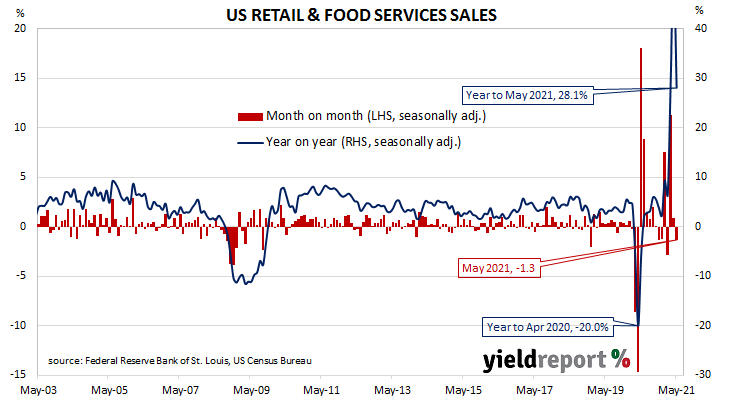Summary: US retail sales decline by 1.3% in May; fall larger than -0.4% expected; initially disappointing but numbers “tell encouraging story”; “move from spending on goods to services “underway”; falls in majority of retail categories; “vehicles and parts” the largest influence.
US retail sales had been trending up since late 2015 but, commencing in late 2018, a series of weak or negative monthly results led to a drop-off in the annual growth rate below 2.0% by the end of that year. Growth rates then increased in trend terms through 2019 and into early 2020 until pandemic restrictions sent it into negative territory. A “v-shaped” recovery then took place which was followed by some short-term spikes as federal stimulus payments hit US households in early 2021.
According to the latest “advance” sales numbers released by the US Census Bureau, total retail sales declined by 1.3% in May. The fall was larger than the 0.4% decrease which had been generally expected and it contrasted with April’s 0.9% rise after it was revised up from zero. On an annual basis, the growth rate slowed from April’s revised figure of 53.4% to 28.1% as the pandemic-induced reduction in spending during the June 2020 quarter continued falling out of the calculations.
NAB senior economist Tapas Strickland said although the result was initially disappointing, “looking under the hood the retail numbers tell an encouraging story.”

The report was released on the same day as May’s industrial production and producer price index (PPI) numbers but US Treasury bond yields hardly moved on the day as markets awaited this week’s FOMC meeting. By the end of the day, 2-year and 10-year Treasury yields remained unchanged at 0.16% and 1.50% respectively while the 30-year yield finished 1bp higher at 2.19%.
Strickland noted April’s figures were revised up and a “pivot from goods to services also appears underway”. He pointed to increased spending on restaurants and bars “with total sending on food-service sales now above pre-pandemic levels.” He thought such a move may “alleviate some of the price pressures being seen on the goods side of the economy.”
The majority of categories recorded lower sales over the month. The “Motor vehicle & parts dealers” segment provided the largest single influence on the overall result, falling by 3.7% for the month while still remaining 34.8% higher for the year. Building materials and general merchandise sales also had significant influences on the total, falling by 5.9% and 3.3% respectively.

